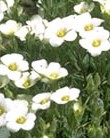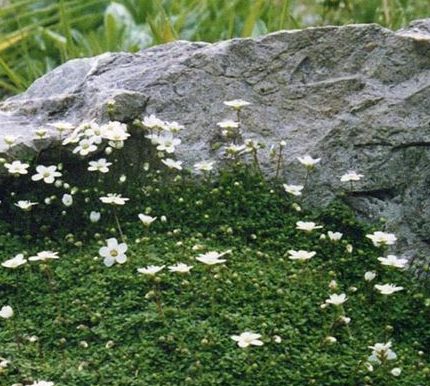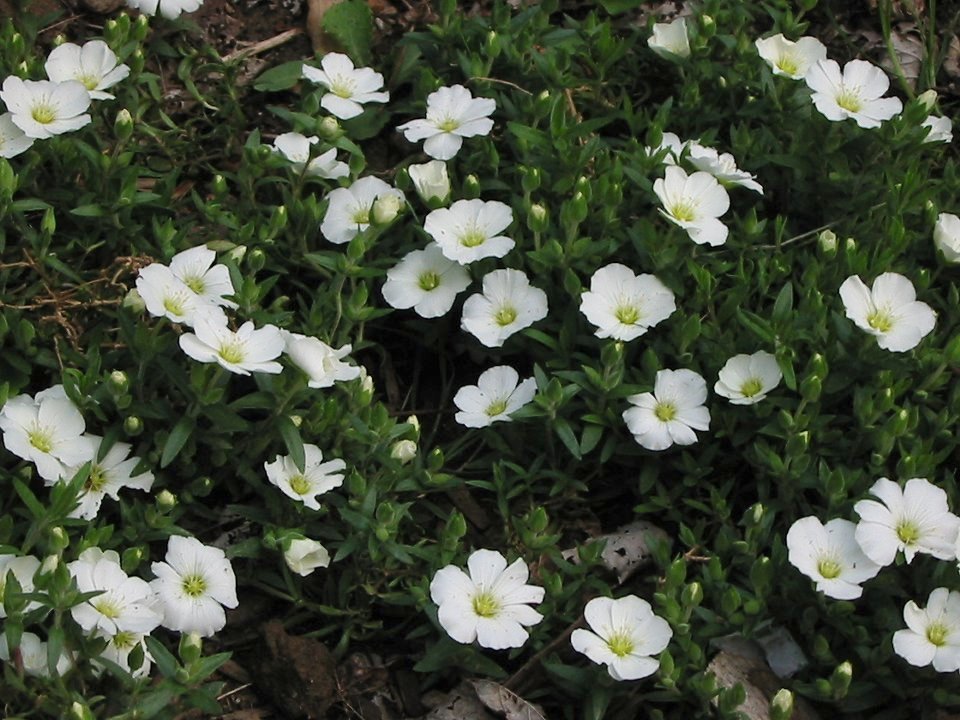
Arenaria, often known as sandwort, is a genus of over 210 species of flowering plants in the carnation family, Caryophyllaceae, that also includes, pinks, baby’s breath, and chickweed. The genus includes herbaceous annuals and perennials that are native to northern temperate regions of North America, Central America, Andes of South America, Eurasian mountains, Mediterranean, and Asia Minor. Three species are garden worthy. They form low dense cushions or mats with small, narrow, evergreen leaves and white 5-petaled flowers in spring. Valued as a groundcover in a rock garden, they grow best in average, sandy or loamy, well-drained, neutral to acidic soil, in full to partial shade. Since the plants are shallow-rooted, they need watering during dry spells. The genus name, Arenaria, comes from the Latin word arena, meaning sand, and refers to the soil of the natural habitat of most, but not all, of the plants. Photo Credit Wikipedia
Corsican Sandwort (A. balearica)

Native to the Balearic Islands, Corsica, Sardinia and mainland Italy, this sandwort grows 1/2-1″ tall and forms a dense moss-like carpet of tiny green leaves with white flowers in spring. Plants need partial shade and well-drained soil that does not dry out in summer, and are a good choice for alpine troughs, between paving stones, and for rock, alpine, and wall gardens. Photo Credit Ghislain-Wikipedia
Height: 1/2″-1″
Light: Partial shade
Hardiness: Zones 5-9
Mountain Sandwort (A. montana)

A native of the mountainous regions of southwestern Europe, from the Pyrenees to Portugal, mountain sandwort grows 2-9″ tall and forms a softly hairy, dense mound of lanceolate to ovate leaves that are 1/8 to 1″ long. From late spring to early summer, dense cymes of 2-10 white, flat, 1/2-1″ wide flowers appear on 1″ stalks. The plants are a good choice for a groundcover, edging in a border or along paths, or for rock , wall, or trough gardens. Photo Credit Mtiffany-71-Wikipedia
Height: 2-9″
Light: Grows best in full sun (with some afternoon shade in the South)
Hardiness: Zones 4-8
Scotch Moss/Moss Sandwort (A. verna)

Not a moss or related to mosses, this native of eastern and western Europe, grows 1-2″ tall, slowly spreading to form a mat up to 10″ wide. The creeping stems carry awl-shaped leaves that are 1/16-1/8″ long . Clusters of star-shaped , 1/2″ wide flowers appear on thin stalks in spring and sporadically thereafter. The plants tend to be short lived but self-seed so usually maintain a presence in the garden. The species is rarely grown but the cultivar ‘Aurea’ is popular for use as a groundcover, around stepping stones, or as an edger along a path as well as in a rock garden or fairy garden. Photo Credit Wikipedia
Hight: 1-2″
Light: Best grown in full sun (with some afternoon shade in the South)
Hardiness: Zones 5-8
Caryophyllaceae, that also includes, pinks, baby’s breath, and chickweed.